air conditioning Mercury Mountaineer 2006 Owner's Manuals
[x] Cancel search | Manufacturer: MERCURY, Model Year: 2006, Model line: Mountaineer, Model: Mercury Mountaineer 2006Pages: 344, PDF Size: 2.66 MB
Page 1 of 344
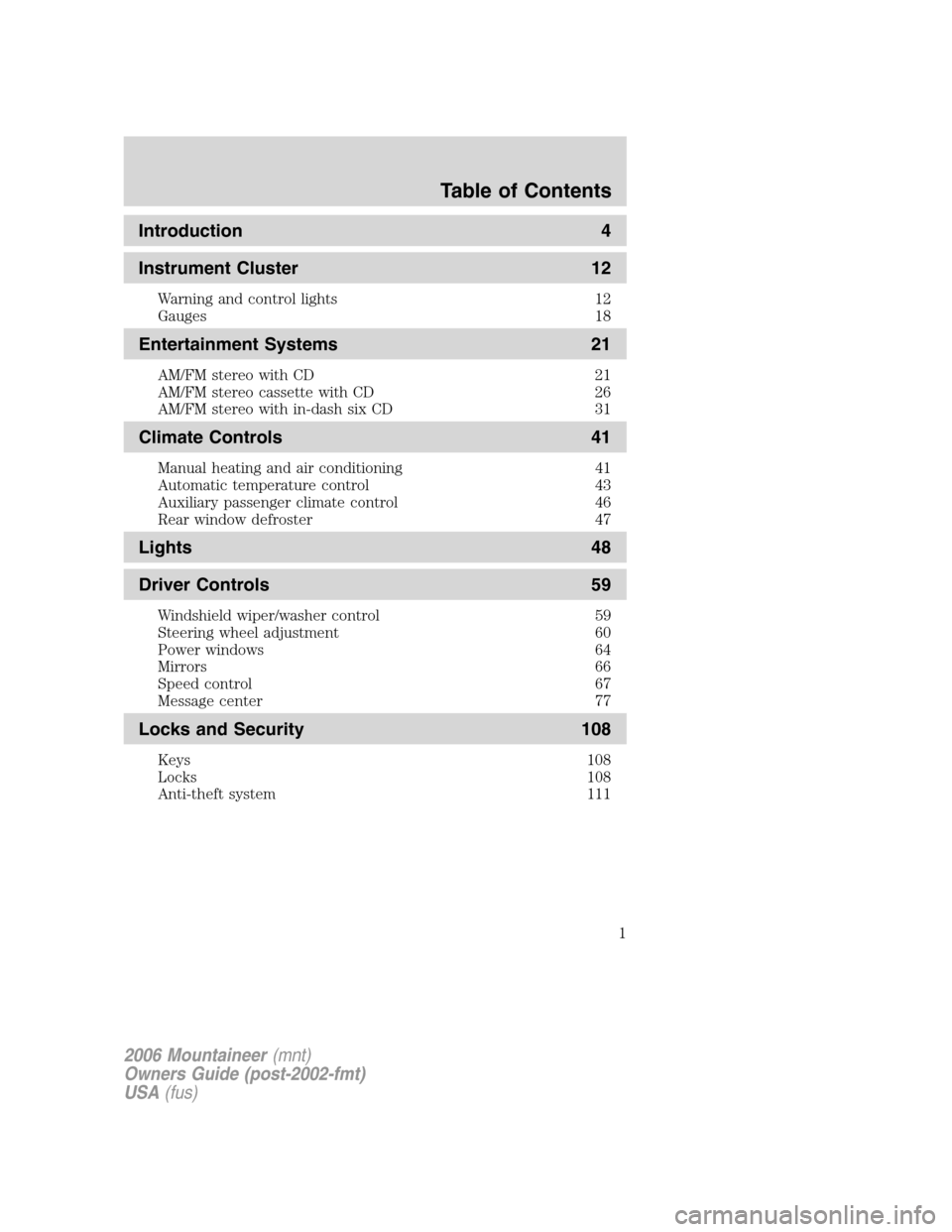
Introduction 4
Instrument Cluster 12
Warning and control lights 12
Gauges 18
Entertainment Systems 21
AM/FM stereo with CD 21
AM/FM stereo cassette with CD 26
AM/FM stereo with in-dash six CD 31
Climate Controls 41
Manual heating and air conditioning 41
Automatic temperature control 43
Auxiliary passenger climate control 46
Rear window defroster 47
Lights 48
Driver Controls 59
Windshield wiper/washer control 59
Steering wheel adjustment 60
Power windows 64
Mirrors 66
Speed control 67
Message center 77
Locks and Security 108
Keys 108
Locks 108
Anti-theft system 111
Table of Contents
1
2006 Mountaineer(mnt)
Owners Guide (post-2002-fmt)
USA(fus)
Page 41 of 344
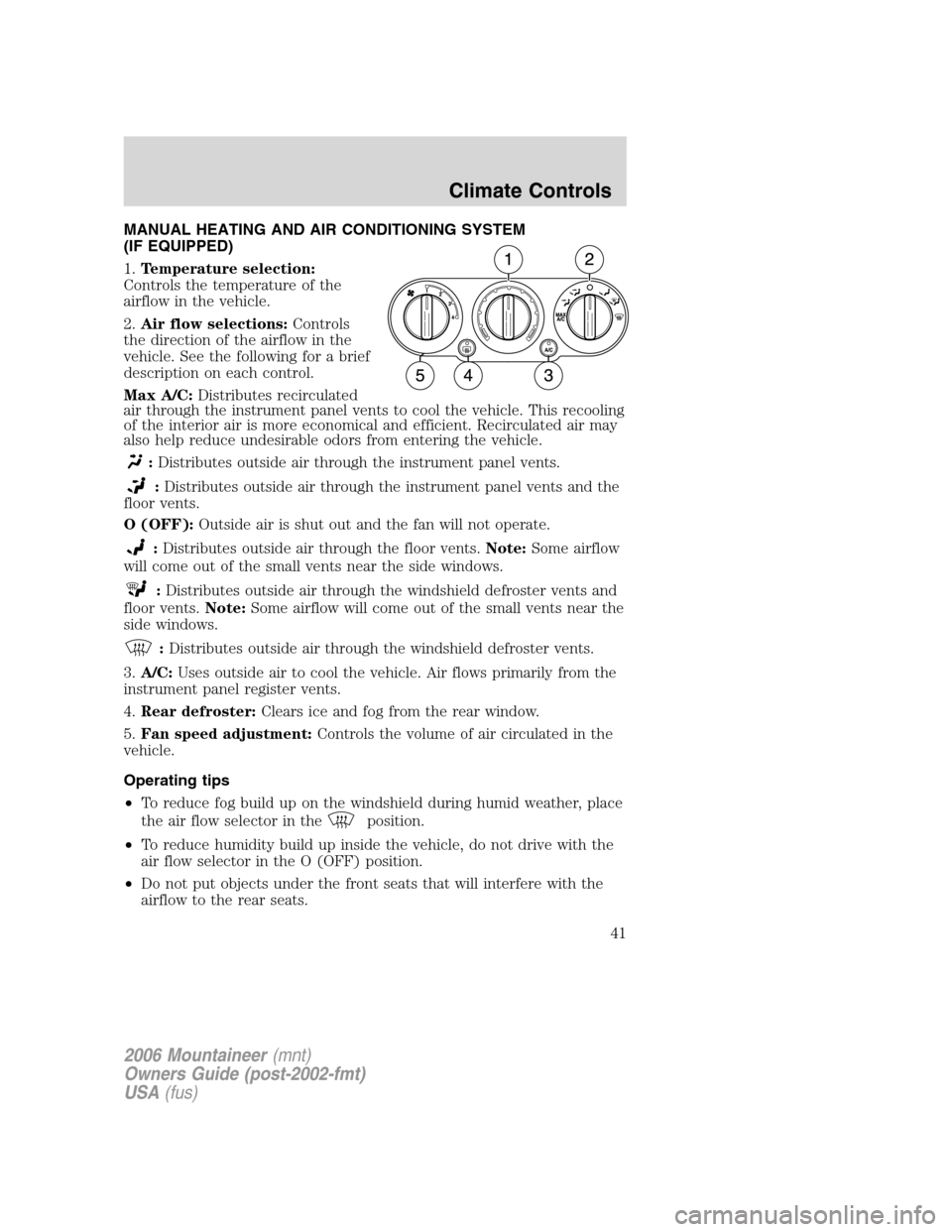
MANUAL HEATING AND AIR CONDITIONING SYSTEM
(IF EQUIPPED)
1.Temperature selection:
Controls the temperature of the
airflow in the vehicle.
2.Air flow selections:Controls
the direction of the airflow in the
vehicle. See the following for a brief
description on each control.
Max A/C:Distributes recirculated
air through the instrument panel vents to cool the vehicle. This recooling
of the interior air is more economical and efficient. Recirculated air may
also help reduce undesirable odors from entering the vehicle.
:Distributes outside air through the instrument panel vents.
:Distributes outside air through the instrument panel vents and the
floor vents.
O (OFF):Outside air is shut out and the fan will not operate.
:Distributes outside air through the floor vents.Note:Some airflow
will come out of the small vents near the side windows.
:Distributes outside air through the windshield defroster vents and
floor vents.Note:Some airflow will come out of the small vents near the
side windows.
:Distributes outside air through the windshield defroster vents.
3.A/C:Uses outside air to cool the vehicle. Air flows primarily from the
instrument panel register vents.
4.Rear defroster:Clears ice and fog from the rear window.
5.Fan speed adjustment:Controls the volume of air circulated in the
vehicle.
Operating tips
•To reduce fog build up on the windshield during humid weather, place
the air flow selector in the
position.
•To reduce humidity build up inside the vehicle, do not drive with the
air flow selector in the O (OFF) position.
•Do not put objects under the front seats that will interfere with the
airflow to the rear seats.
2006 Mountaineer(mnt)
Owners Guide (post-2002-fmt)
USA(fus)
Climate Controls
41
Page 85 of 344

4. Press and hold the reset button
on the compass module for
approximately 4 seconds until
COMPASS ZONE XX appears in the
message center display.
5. Continue to press the reset button until the correct zone appears in
the message center display.
6. After 4 seconds ZONE IS SET will
appear in the message center
display.
7. The display will return to normal
operation. The zone is now updated.
Compass calibration adjustment
Perform compass calibration in an open area free from steel structures
and high voltage lines. For optimum calibration, turn off all electrical
accessories (heater/air conditioning, wipers, etc.) and make sure all
vehicle doors are shut.
1. Start the vehicle.
2. Locate the reset button on the compass sensor mounted on the base
of mirror.
3. To calibrate, press and hold the
reset button on the compass module
for approximately eight seconds and
release.
4. Slowly drive the vehicle in a
circle (less than 5 km/h [3 mph])
until the CIRCLE SLOW TO CALIBRATE display changes to
CALIBRATION COMPLETED. It will take up to five circles to complete
calibration.
5. The compass is now calibrated.
System warnings
System warnings alert you to possible problems or malfunctions in your
vehicle’s operating systems.
2006 Mountaineer(mnt)
Owners Guide (post-2002-fmt)
USA(fus)
Driver Controls
85
Page 99 of 344

Compass calibration adjustment.
Perform compass calibration in an open area free from steel structures
and high voltage lines. For optimum calibration, turn off all electrical
accessories (heater/air conditioning, wipers, etc.) and make sure all
vehicle doors are shut.
1. From the SETUP MENU, press
the SETUP control to select the
compass calibration function.
2. Press RESET for calibration.
3. Slowly drive the vehicle in a
circle (less than 3 mph [5 km/h])
until the CIRCLE SLOWLY TO
CALIBRATE display changes to
CALIBRATION COMPLETE. It will
take up to five circles to complete
calibration.
4. The compass is now calibrated.
Oil life Start Value
1. Select this function from the
SETUP MENU for the current
display mode.
2. Each press of the RESET control
reduces the value by 10 percent.
Note:Oil Life Start Value of 100%
equals 5,000 miles (8,000 km) and
180 days. Setting Oil Life Start
Value to 60% sets the Oil Life Start Value to 3,000 miles (4,828 km) and
120 days.
2006 Mountaineer(mnt)
Owners Guide (post-2002-fmt)
USA(fus)
Driver Controls
99
Page 219 of 344
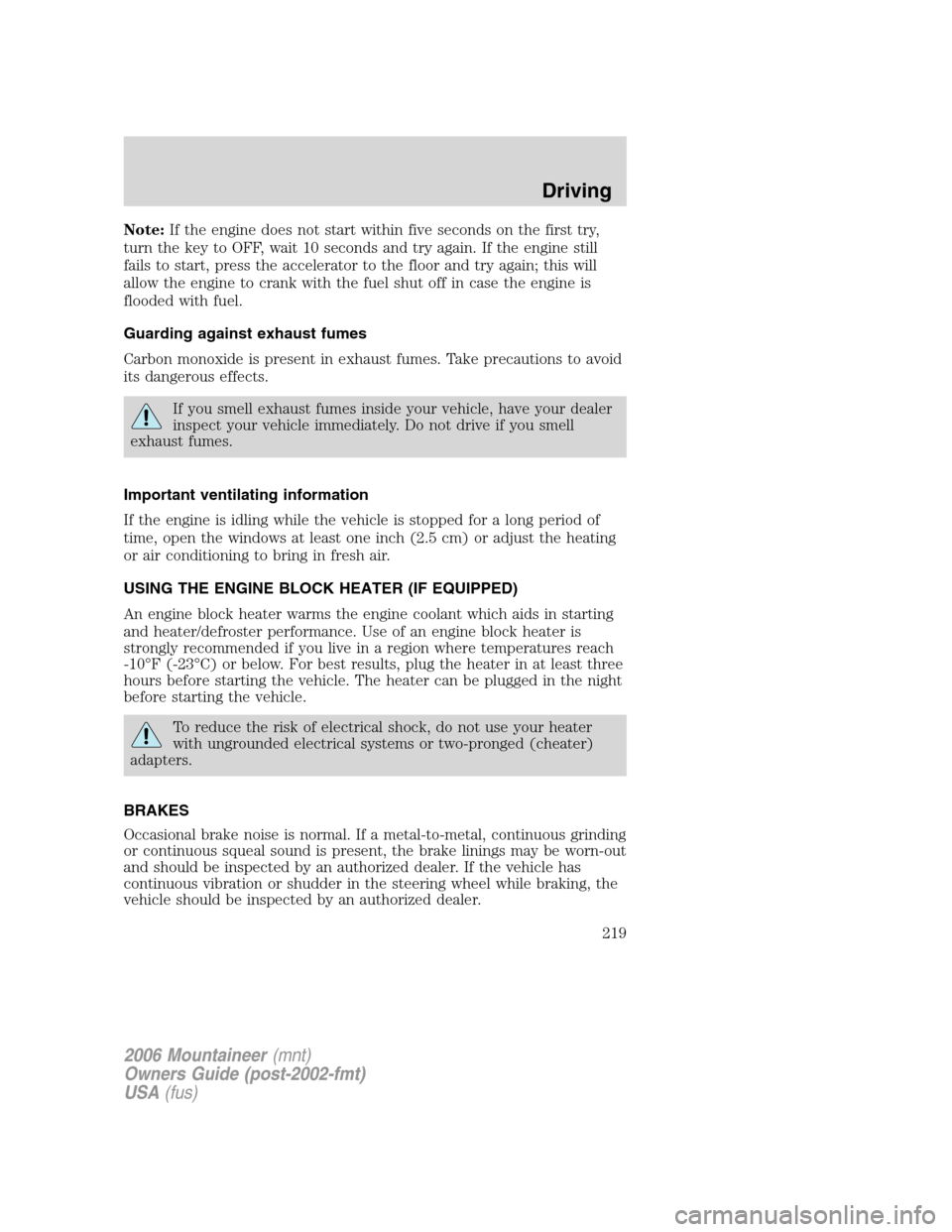
Note:If the engine does not start within five seconds on the first try,
turn the key to OFF, wait 10 seconds and try again. If the engine still
fails to start, press the accelerator to the floor and try again; this will
allow the engine to crank with the fuel shut off in case the engine is
flooded with fuel.
Guarding against exhaust fumes
Carbon monoxide is present in exhaust fumes. Take precautions to avoid
its dangerous effects.
If you smell exhaust fumes inside your vehicle, have your dealer
inspect your vehicle immediately. Do not drive if you smell
exhaust fumes.
Important ventilating information
If the engine is idling while the vehicle is stopped for a long period of
time, open the windows at least one inch (2.5 cm) or adjust the heating
or air conditioning to bring in fresh air.
USING THE ENGINE BLOCK HEATER (IF EQUIPPED)
An engine block heater warms the engine coolant which aids in starting
and heater/defroster performance. Use of an engine block heater is
strongly recommended if you live in a region where temperatures reach
-10°F (-23°C) or below. For best results, plug the heater in at least three
hours before starting the vehicle. The heater can be plugged in the night
before starting the vehicle.
To reduce the risk of electrical shock, do not use your heater
with ungrounded electrical systems or two-pronged (cheater)
adapters.
BRAKES
Occasional brake noise is normal. If a metal-to-metal, continuous grinding
or continuous squeal sound is present, the brake linings may be worn-out
and should be inspected by an authorized dealer. If the vehicle has
continuous vibration or shudder in the steering wheel while braking, the
vehicle should be inspected by an authorized dealer.
2006 Mountaineer(mnt)
Owners Guide (post-2002-fmt)
USA(fus)
Driving
219
Page 305 of 344

•Refer to the chart on the coolant container to ensure the
coolant concentration in your vehicle will provide adequate
protection at the temperatures in which you drive.
Vehicles driven year-round in non-extreme climates should use a 50/50
mixture of engine coolant and distilled water for optimum cooling system
and engine protection.
What you should know about fail-safe cooling (4.6L V8 engine
only)
If the engine coolant supply is depleted, this feature allows the vehicle to
be driven temporarily before incremental component damage is incurred.
The “fail-safe” distance depends on ambient temperatures, vehicle load
and terrain.
Fail-safe cooling and engine oil overheat mode (4.6L V8 only)
If the engine coolant and/or engine oil overheat, the vehicle’s fail-safe
modes will reduce engine power to limit engine damage, even with a
total loss of coolant. The vehicle’s range and/or speed will be reduced,
depending on vehicle load, terrain, and outside temperatures.
The instrument cluster provides warnings for each mode.
•Fail-Safe Cooling Mode:The
(Service engine
soon),
(Engine oil pressure), and(Engine coolant
temperature) indicators will be on.
Along with these warning indicators, the engine coolant temperature
gauge will read in the Hot (H) area.
If the engine coolant reaches even hotter temperatures, fail-safe
cooling mode limits engine power more and disables air conditioning.
The engine will switch to alternating cylinder operation to help cool
the engine. The engine will run rough in this mode.
If continued operation increases the engine coolant temperature to a
critical range, the engine will shut down. Steering and braking effort
will increase. Once engine coolant temperature cools, the engine can
be restarted.
•Engine Oil Overheat Mode:The
(Engine coolant temperature)
indicator will be on. The instrument cluster has no separate oil
temperature indicator.
Along with the
(Engine coolant temperature) indicator, the engine
coolant temperature gauge will read in the Hot (H) area.
2006 Mountaineer(mnt)
Owners Guide (post-2002-fmt)
USA(fus)
Maintenance and Specifications
305
Page 332 of 344
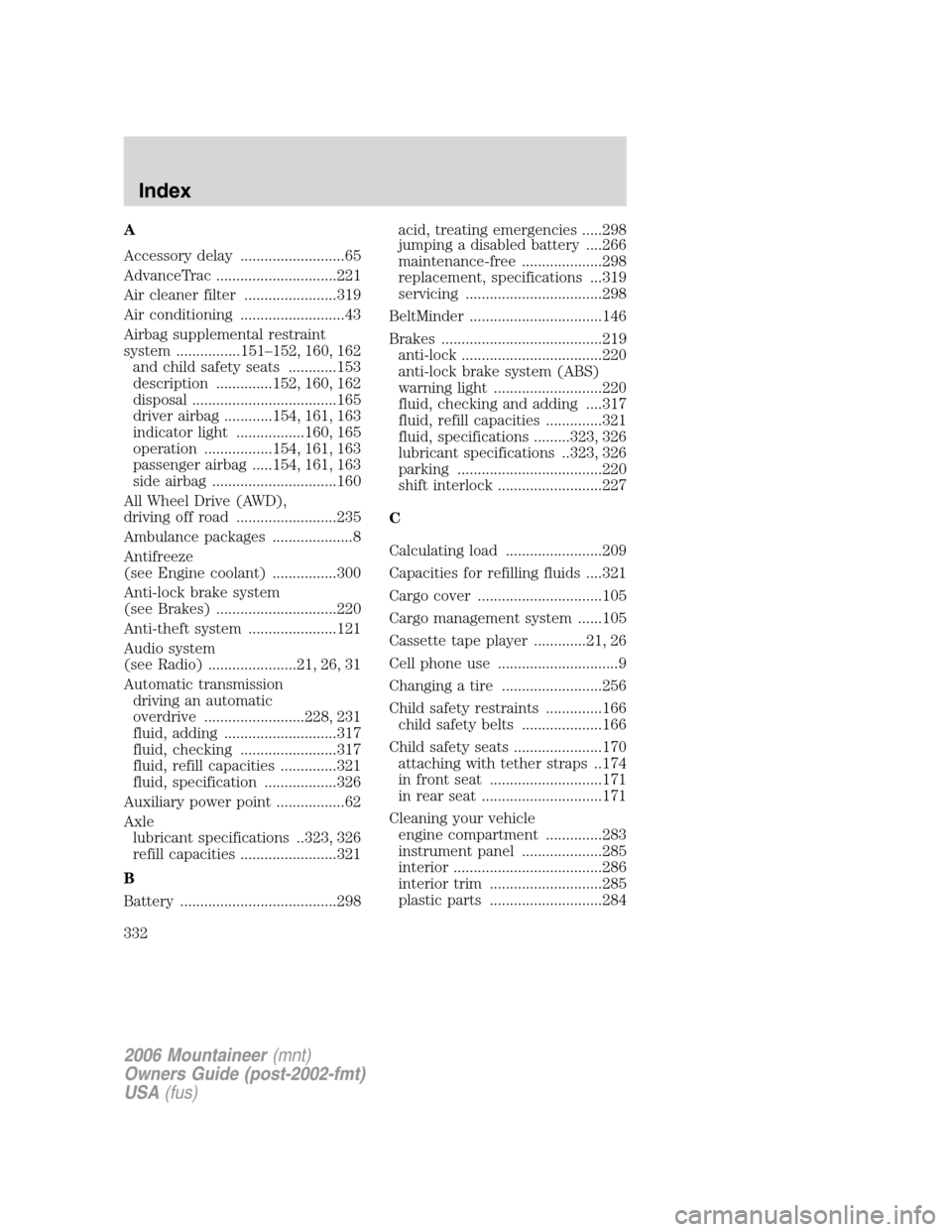
A
Accessory delay ..........................65
AdvanceTrac ..............................221
Air cleaner filter .......................319
Air conditioning ..........................43
Airbag supplemental restraint
system ................151–152, 160, 162
and child safety seats ............153
description ..............152, 160, 162
disposal ....................................165
driver airbag ............154, 161, 163
indicator light .................160, 165
operation .................154, 161, 163
passenger airbag .....154, 161, 163
side airbag ...............................160
All Wheel Drive (AWD),
driving off road .........................235
Ambulance packages ....................8
Antifreeze
(see Engine coolant) ................300
Anti-lock brake system
(see Brakes) ..............................220
Anti-theft system ......................121
Audio system
(see Radio) ......................21, 26, 31
Automatic transmission
driving an automatic
overdrive .........................228, 231
fluid, adding ............................317
fluid, checking ........................317
fluid, refill capacities ..............321
fluid, specification ..................326
Auxiliary power point .................62
Axle
lubricant specifications ..323, 326
refill capacities ........................321
B
Battery .......................................298acid, treating emergencies .....298
jumping a disabled battery ....266
maintenance-free ....................298
replacement, specifications ...319
servicing ..................................298
BeltMinder .................................146
Brakes ........................................219
anti-lock ...................................220
anti-lock brake system (ABS)
warning light ...........................220
fluid, checking and adding ....317
fluid, refill capacities ..............321
fluid, specifications .........323, 326
lubricant specifications ..323, 326
parking ....................................220
shift interlock ..........................227
C
Calculating load ........................209
Capacities for refilling fluids ....321
Cargo cover ...............................105
Cargo management system ......105
Cassette tape player .............21, 26
Cell phone use ..............................9
Changing a tire .........................256
Child safety restraints ..............166
child safety belts ....................166
Child safety seats ......................170
attaching with tether straps ..174
in front seat ............................171
in rear seat ..............................171
Cleaning your vehicle
engine compartment ..............283
instrument panel ....................285
interior .....................................286
interior trim ............................285
plastic parts ............................284
2006 Mountaineer(mnt)
Owners Guide (post-2002-fmt)
USA(fus)
Index
332
Page 333 of 344

washing ....................................281
waxing .....................................281
wheels ......................................282
wiper blades ............................284
Climate control (see Air
conditioning or Heating) ............43
Clock adjust
6-CD in dash .............................32
AM/FM/CD .................................22
AM/FM/Tape/CD .......................27
Compass, electronic ....................83
calibration .................................85
set zone adjustment ...........84, 98
Console ..................................63–64
overhead ....................................61
rear ............................................64
Controls
power seat ...............................126
steering column ........................70
Coolant
checking and adding ..............300
refill capacities ................304, 321
specifications ..................323, 326
Cruise control
(see Speed control) ....................67
Customer Assistance ................245
Ford Extended Service
Plan ..........................................278
Getting assistance outside the
U.S. and Canada .....................278
Getting roadside assistance ...245
Getting the service you
need .........................................274
Ordering additional owner’s
literature .................................279
Utilizing the
Mediation/Arbitration
Program ...................................277D
Daytime running lamps
(see Lamps) ................................49
Defrost
rear window ..............................47
Dipstick
automatic transmission
fluid ..........................................317
engine oil .................................293
Doors
lubricant specifications ..........323
Driveline universal joint and
slip yoke ....................................318
Driving under special
conditions ..................234, 239, 242
sand .........................................240
snow and ice ...........................243
through water .................241, 244
Dual automatic temperature
control (DATC) ...........................43
DVD system .................................40
E
Electronic message center ...77, 88
Emergencies, roadside
jump-starting ..........................266
Emergency Flashers .................247
Emission control system ..........314
Engine ........................................326
cleaning ...................................283
coolant .....................................300
fail-safe cooling .......................305
idle speed control ...................298
lubrication
specifications ..................323, 326
refill capacities ........................321
2006 Mountaineer(mnt)
Owners Guide (post-2002-fmt)
USA(fus)
Index
333
Page 334 of 344
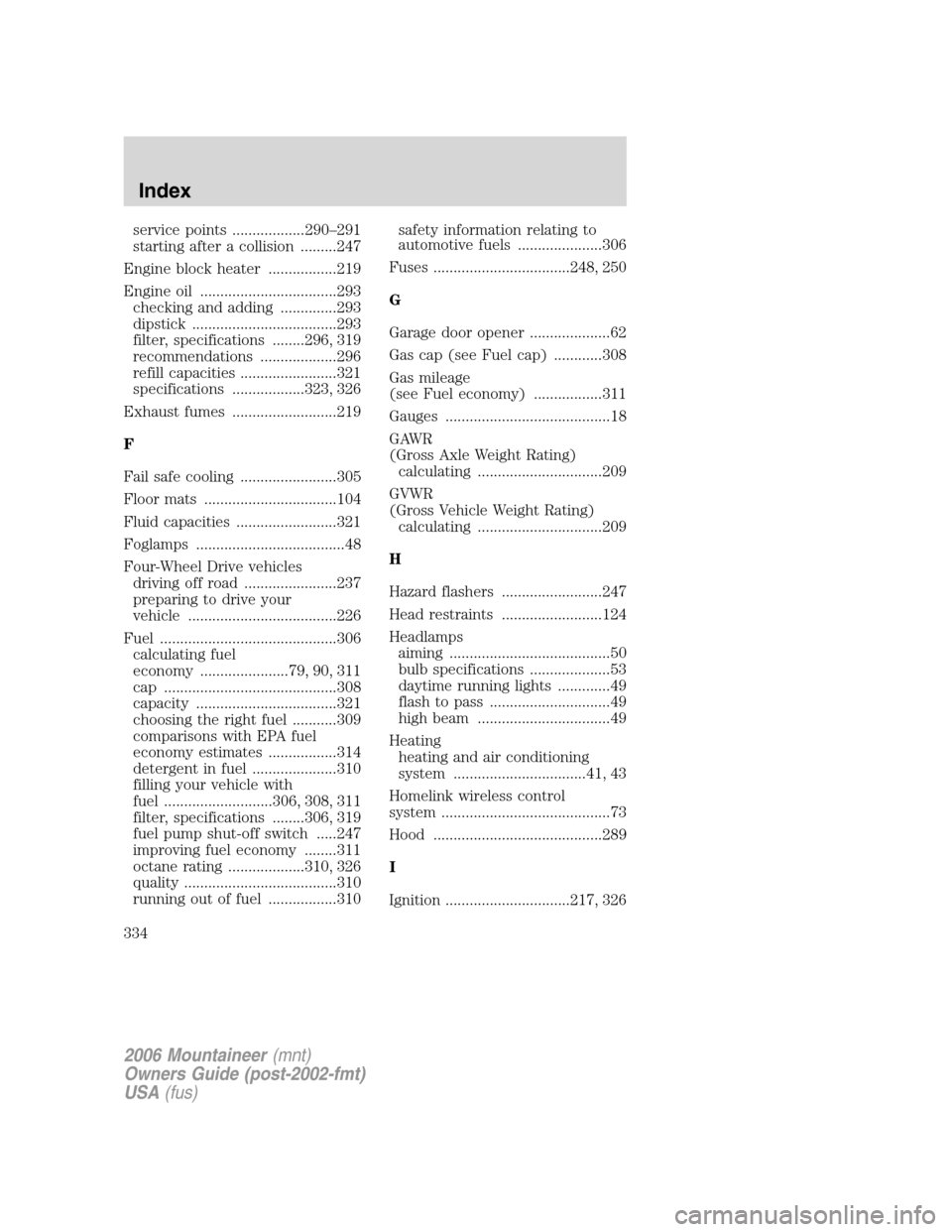
service points ..................290–291
starting after a collision .........247
Engine block heater .................219
Engine oil ..................................293
checking and adding ..............293
dipstick ....................................293
filter, specifications ........296, 319
recommendations ...................296
refill capacities ........................321
specifications ..................323, 326
Exhaust fumes ..........................219
F
Fail safe cooling ........................305
Floor mats .................................104
Fluid capacities .........................321
Foglamps .....................................48
Four-Wheel Drive vehicles
driving off road .......................237
preparing to drive your
vehicle .....................................226
Fuel ............................................306
calculating fuel
economy ......................79, 90, 311
cap ...........................................308
capacity ...................................321
choosing the right fuel ...........309
comparisons with EPA fuel
economy estimates .................314
detergent in fuel .....................310
filling your vehicle with
fuel ...........................306, 308, 311
filter, specifications ........306, 319
fuel pump shut-off switch .....247
improving fuel economy ........311
octane rating ...................310, 326
quality ......................................310
running out of fuel .................310safety information relating to
automotive fuels .....................306
Fuses ..................................248, 250
G
Garage door opener ....................62
Gas cap (see Fuel cap) ............308
Gas mileage
(see Fuel economy) .................311
Gauges .........................................18
GAWR
(Gross Axle Weight Rating)
calculating ...............................209
GVWR
(Gross Vehicle Weight Rating)
calculating ...............................209
H
Hazard flashers .........................247
Head restraints .........................124
Headlamps
aiming ........................................50
bulb specifications ....................53
daytime running lights .............49
flash to pass ..............................49
high beam .................................49
Heating
heating and air conditioning
system .................................41, 43
Homelink wireless control
system ..........................................73
Hood ..........................................289
I
Ignition ...............................217, 326
2006 Mountaineer(mnt)
Owners Guide (post-2002-fmt)
USA(fus)
Index
334